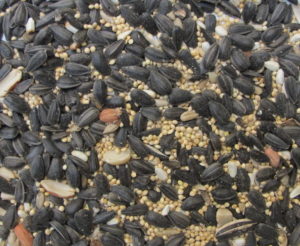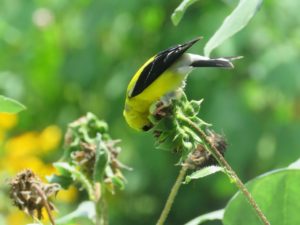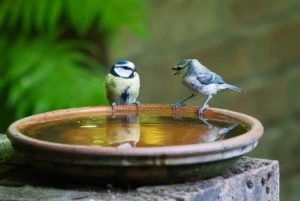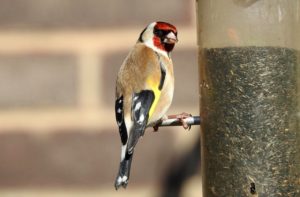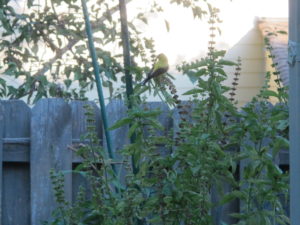Page 2
Feeding American Goldfinches: To Feed Or Not To Feed
Some birdwatching websites recommend feeding goldfinches only from November through March. Offering food early in the spring/summer season, they claim, might encourage nesting before natural food sources become plentiful in late summer. American goldfinches naturally begin nesting later than most songbirds for that reason.
But, if we incentivized goldfinches to stay through the winter, how much food is enough to keep them around but not to encourage them to begin nesting? I assume the birds know the proper time to nest by reading environmental clues, i.e., wild seed availability and weather. But I can’t imagine we’d be doing them a favor by withholding food in March!
On The Menu
Photograph (above) shows a sample of seed from the warehouse club. It has a large proportion of black oil sunflower seeds, and also white millet, peanuts, and safflower. After I give the feeder a good shake, brown-headed nuthatches show up immediately to grab the white safflower seeds.
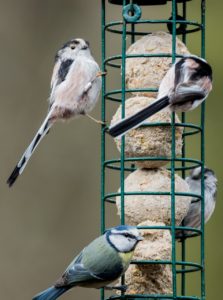 Suet and nut butters are fine for birds in cool weather, but it can damage their feathers in warm weather. Feathers become coated with melted oils, which the birds can’t remove. Another option is a feeder that holds balls of suet and seeds (photo, right). This keeps the fat at a safe, but reachable, distance.
Suet and nut butters are fine for birds in cool weather, but it can damage their feathers in warm weather. Feathers become coated with melted oils, which the birds can’t remove. Another option is a feeder that holds balls of suet and seeds (photo, right). This keeps the fat at a safe, but reachable, distance.
Dried mealworms are difficult to digest. The chiton clogs their system, especially in young birds, and the worms are low in calcium. Someone else will probably eat them, but buy seeds for American goldfinches.
Offer less bread, and more cracked corn and oats, and their favorites, nyjer and black oil sunflower seeds. In our yard, squirrels love the whole grain bread. (In an experiment, I prepared a potful of old white rice that had been in the pantry since before I moved here. After sitting on the deck for a few days, right under the bird feeder, it was removed to the trash. Not one bit of it had disappeared.)
Feeders
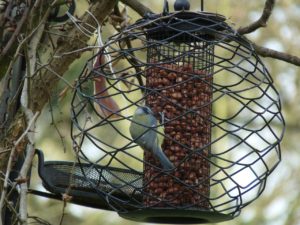
The wire cage covering the feeder (photo, above) cleverly permits small birds to approach the feeder. But it excludes squirrels and large birds. For many bird watchers, squirrels are an absolute pain in the neck. I made my peace with them long ago, resolving simply to buy more seed.
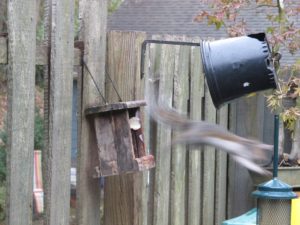 When my sister, Lisa, visited from California, she slipped a plastic nursery pot over the bracket holding the feeder, and now it’s more difficult for the squirrels to get to the seeds. They still try, though, launching from the box feeder instead (photo, right).
When my sister, Lisa, visited from California, she slipped a plastic nursery pot over the bracket holding the feeder, and now it’s more difficult for the squirrels to get to the seeds. They still try, though, launching from the box feeder instead (photo, right).
Goldfinches refuse old stale food, and any that has begun to mold. A feeder with a baffle on top shields the seed from most of the rain. If you don’t have American goldfinches yet, and are putting out food to attract them, use a small amount to begin with. It can take a while for them to find the feeder and to habituate themselves to regular visits. But once they find it, they’ll tell all their friends.
On Sunflowers
Helianthus annuus, the common sunflower, has become such a popular cut flower that there are now dozens of varieties available. It has long been a farmers’ market favorite. From the short ‘Big Smile’ to the towering old ‘Mammoth Russian’, in yellow, gold, orange, ‘Moulin Rouge’ red…gorgeous, perfect for fall decorating. And many are conveniently pollenless!
Black oil sunflower seed husks are thinner and easier to crack open. If you have seedheads of the larger grey stripe kind, the finches probably will take them. You can make the task a bit easier by mashing them somewhat.
Some gardeners grow their own sunflowers for their winter feeding stations. The plants grow all season, producing the often massive seedheads in late summer to early fall. When the green parts below the flower turn brown and the seeds show appropriate color, the stems are ready to cut. But, curiously, not all sunflower heads have filled seeds inside. A sad disappointment, certainly, if the purpose was to harvest edible seeds for the birds or for yourself.
Pollenless or nearly pollenless varieties have tightly packed petals, less nectar, and compromised reproductive parts. They, therefore, have lost the ability to produce filled seeds. The fact that they attract fewer pollinators doesn’t help. Seed packet information for each variety should indicate whether it produces edible seeds. All sunflowers produce edible petals. Descriptions of the flavor of petals include nutty, bitter, or like artichokes. We can also grow sunflower seeds to harvest as shoots.
Johnny’s Selected Seeds lists a cultivar called ‘Royal Hybrid 1121’, which grows to 7′ tall and yields grey stripe sunflower seeds. Look for ‘Black Peredovik’ and ‘Hopi Black Dye’, black oil types. Other edible seed producers include ‘Giganteus’, ‘Kong Hybrid’, ‘Mammoth Grey Stripe’, ‘Sunzilla’, ‘Super Snack’, and ‘Titan’.
Weeds and Water
Burdock, that nasty weed with the sticky seedpods (burs) that get stuck in your sweater and in the dog’s fur can kill small birds, so remove it if possible.
All birds appreciate a source of clean water, offered year-round. A concrete or ceramic bird bath with a non-slippery surface, a small pond, a functioning fountain, or a simple large plastic saucer will do. Place it where the birds can see any threats to their safety and where the neighbor’s cat won’t be able to pounce from the greenery.
Refresh the water at least every 2 or 3 days in summer. Mosquitoes need only a few days to complete their life cycle from the time eggs are laid in the water to the first bloody bite.
Cleaning bird baths, feeders, and surrounding areas will help prevent crusty eye infections that spread through the flock.
Nesting
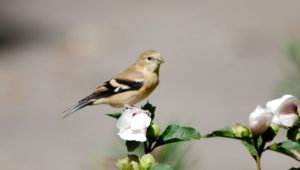
Female goldfinch or winter plumage.
American goldfinches are the only finches that molt twice a year, in late winter and after the first clutch. Occasionally, a mating pair will have a second clutch. The males have much duller plumage in winter, and females generally have more subtle coloration than the males.
Most nesting activity occurs between late June and August. The male goldfinch flutters in flight, singing to the female and impressing her with his bright yellow and black plumage. Male American goldfinches are monogamous, mating with only one female in a season.
To hear recordings of songs and calls for the delightful American goldfinch, check out the Cornell Lab of Ornithology website.
The Nest
Where stems branch in the trees, American goldfinches build nests with an interior diameter of about 2.6″. Suitable sites include dogwood, elderberry, hawthorn, willow, Monterey pine, and dense evergreens. They’ll also nest in fruit trees, and sometimes thistle thickets or dense weeds. Goldfinches are not particularly choosy about the kind of tree they nest in, as long as the stems will securely hold the nest. They’re built from a few feet off the ground to 10′, and occasionally up to 30′. They will not use nest boxes if you offer them.
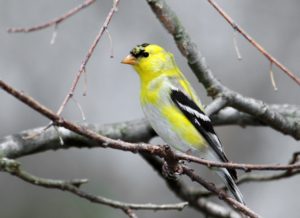
Although both the female and the male gather vines, plant fibers, bark, thistle down, and grass for the nest, the female spends up to 6 days constructing it. She finishes the rim with spider and insect silk and bark. The inside of the nest is lined with milkweed, cattail, and thistle down, and also dandelion and cottonwood tree pappi (seed “fluff”).
Birds might gather small dry strips of cotton or wool cloth, hanging under cover in a mesh bag. And they also help themselves to the coco liner in the wire basket.
It is said that the goldfinch’s nest is so tightly constructed that it can hold water. The 5″ long birds use their wings to shield the nestlings from drowning. She lays between 2 and 7 pale blue eggs and incubates them for 12 to 14 days. The male feeds the female during this period.
The Nestlings
Both parents feed the nestlings a diet composed almost entirely of regurgitated seeds. This is why they breed late in the season, at a time when seeds are abundantly available.
The role of the female gradually decreases as the chicks mature, and the male then becomes the primary provider. The young leave the nest 11 to 17 days after hatching.
Cowbirds
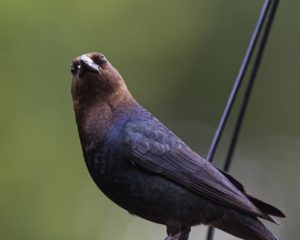
Brown-headed cowbird.
Brown-headed cowbirds (throughout the U.S.), bronzed cowbirds (Gulf coast to southern AZ, Mexico), and shiny cowbirds (a rare visitor from the Caribbean to the southeast U.S.), are known as “brood parasites”. Females lay eggs in nests of other species, abandoning the young to be raised by their foster parents.
The cowbirds’ attempts to have their chicks raised by goldfinches are futile, however, because of diet. After a few days of eating seeds, the cowbirds die because their nutritional needs cannot be met.
Other Goldfinches
The lesser goldfinch is slightly smaller than the American goldfinch. It has more black or green coloring on its head and back, depending on region. This bird is found from coastal Oregon and California to Colorado and western Texas, and in Mexico.
Lawrence’s goldfinch is mostly gray or brown, with bright yellow patches in the wings. This uncommon bird travels in small groups, mainly in California to Arizona and near the Mexican border.
The pine siskin often flocks with the American goldfinch in winter. Plumage resembles a sparrow’s, but the siskin has a plain face and some yellow on the wings. The yellow is more noticeable when the bird is in flight. Also, its beak is slightly narrower than the sparrow’s. Its range is similar to that of the American goldfinch, occurring in smaller numbers east of the Rocky Mountains. It breeds farther north into Canada.
The European goldfinch is unmistakable, with its red face bordered by white, and bright yellow bands on the wings. This finch is commonly found in Europe, northern Africa, and western Asia. It has been introduced into Australia, New Zealand, and Bermuda. Occasionally, a European goldfinch is spotted in the eastern U.S.
A New Perspective in Gardening
Declining populations of songbirds might seem inconsequential to some. To expect them to get by without effect in an aberration of vegetation—the modern landscape and the way we manage it—is a fantasy.
But that’s only one weakening link in the local food chain. All life, from the microscopic soil-dwellers, to caterpillars and other insects that eat our plants, to frogs and snakes, to pollinators, birds and foxes, and to us…in farm, field, and forest… We’re all interdependent.
Maybe, for the sake of biodiversity, we should reconsider our overly neat and increasingly monocultured properties. A landscape with expansive lawns and the token shade tree leaves much room for improvement.
Our vanishing songbird populations and, indeed, all natural ecosystems need your help. By planting a wide variety of trees, shrubs, grasses, and flowers that serve as food and shelter for each link in that chain, each of us can do our part. In every way, the environment will benefit.
Some Simple Fixes To Help American Goldfinches
- Use more native species and their varieties. Native plants host populations of local insects and have seeds which local songbirds evolved with and rely upon.
- Plant a diversified landscape using layers of greenery—trees, shrubs, and herbaceous plants, evergreen and deciduous.
- If you own acreage, convert some of the property back to native growth instead of investing time, labor, and resources into a huge lawn.
- Maybe you and your family could establish a Certified Wildlife Habitat.
- Use fewer chemicals.
- Keep the cats indoors.
- Let some of autumn’s leaves and twigs collect in brush piles under trees. This is prime habitat for larval and overwintering insects, and provides shelter for birds and other small animals.
- Provide fresh water.
- Let the cosmos, coneflowers, sedum, rudbeckias, and other seedy plants remain standing through the winter.
A slight shift in how we think of the context of our existence on this planet will help insure survival of the greatest number of species. But doing nothing will hasten their decline.
If feeding the birds brings you one step closer to a full appreciation of nature’s importance, then job well done!
Headings
Page 1: American Goldfinches and Basil, Memories From Childhood (To the Rescue!, Cedar Waxwings), Migrations, Habitat (Median Strips), Food Sources (Perennials, Annuals, Trees and Shrubs, Greens)
Page 2: Feeding American Goldfinches: To Feed Or Not To Feed (On the Menu, Feeders, On Sunflowers), Weeds and Water, Nesting, Cowbirds, Other Goldfinches, a New Perspective In Gardening (Some Simple Fixes To Help American Goldfinches)
